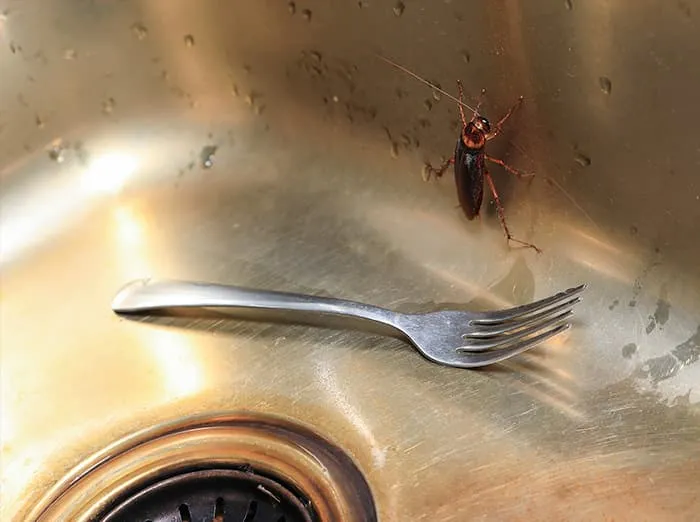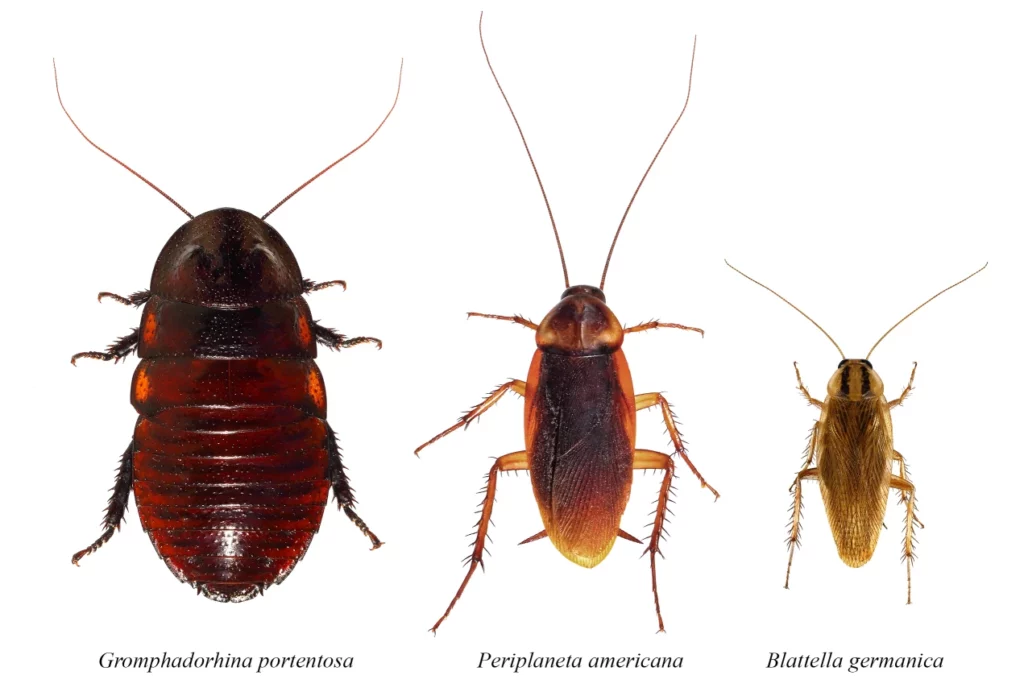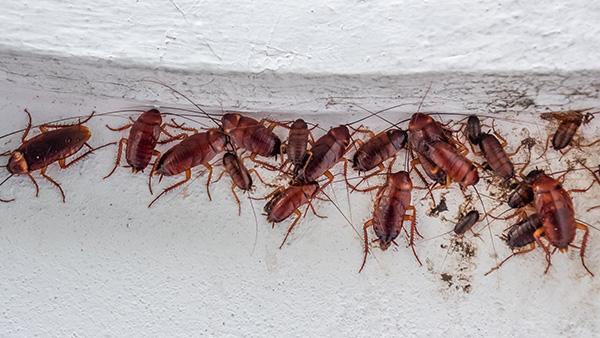Cockroach Treatments in Florida
Exterminator Services for Deltona, DeLand, DeBary, Orange City, Eustis, and Lake Helen
Florida’s subtropical conditions – featuring mild winters, consistent warmth, and abundant humidity – draw residents, tourists, and unfortunately, cockroaches. These adaptable insects find moisture, steady temperatures, and easy food sources if occupant housekeeping or building seals leave gaps. In Deltona, as well as neighboring areas like DeLand, DeBary, Orange City, Eustis, and Lake Helen, roach infestations can escalate quickly if the early signs go unheeded. This service page delves into why roaches thrive in Florida’s environment, how to detect an incipient infestation, and why partnering with a professional cockroach exterminator for cockroach treatments is vital to reclaiming a sanitary and comfortable home or business. Acting promptly when droppings appear or roaches scatter at night spares you from deeper contamination, occupant anxieties, and the frustration of repeated do-it-yourself attempts that only partially suppress these resilient pests.
Understanding Florida’s Ant Population

- Mild Winter Climate
In cooler regions, long freezing winters naturally cull roach populations or push them into dormancy for months. Florida’s winter seldom dips below freezing, letting roaches feed, reproduce, and move indoors continually. Heated or air-conditioned buildings further ensure stable warmth, allowing roaches to flourish year-round unless occupant vigilance or professional solutions intervene. - High Humidity and Moisture
Roaches need water sources – leaky pipes, damp under-sink areas, condensation near air conditioners – to survive. Florida’s moist air and frequent rainfall maintain conditions roaches adore, from dark corners behind refrigerators to bathrooms with minor plumbing leaks. Without occupant-based dryness measures or quick occupant checks, roaches easily find spaces to hide and breed. - Minimal Seasonal Dormancy
In states with sustained sub-zero winters, roach breeding may slow or stall. Areas like Deltona, with mild Florida temperatures, rarely force roaches into dormancy. A minor infiltration left unaddressed can balloon rapidly as occupant or manager routines seldom receive a winter break from roach presence. - Ample Food Opportunities
Roaches consume nearly any organic matter, from stray crumbs or unsealed pet food containers to leftover garbage or grease-laden kitchen corners. Busy occupant lifestyles or limited cleaning habits – such as rarely wiping counters or leaving food scraps out – present roaches with daily buffets. Coupled with mild weather, occupant routines rarely disrupt roach survival beyond a professional approach. - Frequent People and Goods Movement
With occupant transitions, short-term rentals, and secondhand furniture, roaches can hitch rides in cardboard boxes, used appliances, or hidden in produce crates. Introduced to new locations, roaches scuttle behind walls or nest in corners if occupant detection or building management is absent. Mild Florida temperatures leave them free to establish quickly.
Early Clues of a Cockroach Infestation
- Droppings
Varied roach species produce different droppings. German roaches leave pepper-like specks or small smears, while American roaches leave bigger, cylindrical pellets. Fresh droppings appear dark, often found near food sources, behind stoves, or in cupboards. Discovering these clusters strongly confirms active roach traffic. - Egg Casings (Oothecae)
Roach egg capsules, brownish and segmented, can be glued to hidden surfaces or left in corners. Spotting these near cabinets or along baseboards reveals active breeding. Some species carry egg capsules until hatching, so not all are left behind, but any presence indicates ongoing reproduction. - Musty or Oily Odor
When roach populations grow, a distinct musty smell can linger in rooms or cabinets. Even smaller groups can generate an oily odor occupant might notice near hidden damp spots or clustered droppings. Combining odor with droppings or egg cases validates roach activity. - Nighttime Sightings
Roaches are nocturnal, emerging after dark. Turning on kitchen or bathroom lights at night to see roaches scattering signals an advancing infestation. Observing them during daytime frequently indicates overcrowding forced some out of typical hiding zones – emphasizing the seriousness of the problem.
Smudge Marks
In humid areas, roaches often leave smear marks along walls where they frequently traverse. These dark streaks appear near damp corners, behind sinks, or along baseboards roaches repeatedly travel. Repeated occupant sightings of these lines suggests roaches are well established.

Each ant species brings its own unique challenges. From the hidden dangers of carpenter ants damaging wood to the painful stings of fire ants in the yard, understanding which species you’re dealing with helps to inform the best control measures.
Why Ant Infestations Require Prompt Attention
Although ants may seem like a minor inconvenience at first, they can quickly escalate into a major problem. Their ability to organize, communicate, and exploit food sources makes them formidable household pests. Below are a few reasons why you’ll want to address ant problems as soon as possible:
- Health Concerns: While most ants don’t transmit serious diseases, they can still carry germs on their bodies. Ants are known to crawl through garbage, bathrooms, and other unsanitary locations, then contaminate food-prep surfaces.
- Property Damage: Species such as carpenter ants can weaken wood over time, leading to structural issues. Fire ants may damage lawns, while others may chew through insulation or wiring in walls.
- Rapid Reproduction: Ants reproduce rapidly. A colony that starts small in a hidden corner can expand significantly in just a few weeks. Delaying treatment allows them to firmly establish themselves in your living or working spaces.
- Persistent Trails: Once ants have mapped out a reliable source of food or water, they lay down chemical pheromone trails. This encourages more ants to follow, compounding the infestation problem.
Taking quick action stops these issues from spiraling out of control and helps you maintain a comfortable, hygienic environment for your family or employees.
Our Approach to Ant Control
One-size-fits-all approaches rarely work when dealing with Florida ants. Different species have distinct nesting habits, diets, and environmental preferences. That’s why we customize our methods to ensure you get lasting results.
- Assessment and Identification
We begin each service by determining the type or types of ants present. Identifying the species correctly sets the stage for an effective control strategy. For instance, if we discover carpenter ants, we’ll look for moist or decaying wood that could serve as prime nesting sites, whereas ghost ants might lead us to water sources in kitchens or bathrooms. Accurate assessment prevents misapplication of treatments and ensures long-term success. - Targeted Treatment
After pinpointing problem areas, we use targeted methods that disrupt the ants’ life cycle. Treatments may involve locating and treating the nest itself, eliminating trails, and placing repellents or baits in strategic locations. For interior infestations, we use approaches that minimize disruption to your daily routine, focusing on cracks, crevices, and hidden voids where ants like to hide. Outdoor treatments may include a perimeter barrier around your property, reducing the likelihood of future intrusions. - Non-Invasive Techniques
We believe in addressing ant problems while also being mindful of the environment around your home or business. Using non-invasive techniques can include carefully placed baits that lure ants away from your living spaces and targeted sprays that disrupt ants’ scent trails. By using these focused methods, we aim to reduce chemical use and focus on the spots where ants are most active. - Recommendations for Prevention
Prevention is equally crucial in ant control. During and after treatment, we’ll share practical tips to help you maintain an ant-free environment. This could include sealing gaps around windows and doors, repairing leaks, storing food in airtight containers, and managing indoor humidity levels. By making small changes, you’ll reduce the conditions that encourage ants to set up shop in your space.Why Prompt Cockroach Treatments Are Critical
Health and Sanitation
Roaches may transmit pathogens by leaving droppings on counters, stored foods, or utensils. Their presence can aggravate allergies or asthma in susceptible individuals. Eliminating them early protects occupant well-being and supports a hygienic property environment.Rapid Population Growth
Certain species, like German roaches, multiply swiftly. A few overlooked roaches can become a swarm occupying multiple rooms in a matter of weeks. Early occupant or professional action – upon discovering droppings or glimpsing roaches at night – keeps the infestation from overwhelming living areas or entire floors.Property Image or Brand Reputation
For restaurants, short-term rentals, or lodging facilities, roach sightings drive occupant discontent and negative online reviews. Even in residences, occupant or guest alarm surfaces with repeated scurrying or droppings. Swift occupant or manager solutions ease occupant fears and uphold the property’s standing.Daily Anxiety
Living with roaches fosters occupant stress, from discovering droppings near morning dishes to flipping on lights and seeing them scatter. Comprehensive extermination restores occupant comfort, letting families or employees focus on normal routines.
Why a Professional Exterminator Is Key
Complete Assessment
A cockroach exterminator explores potential hideouts—like behind appliances, under sinks, near water lines—documenting droppings or egg casings to map roach species (German, American, smoky brown) and their main runways. A thorough approach clarifies how to place baits or insect growth regulators for maximum effect.Strategic Trapping and Baiting
Over-the-counter foggers can push roaches deeper into cracks. Professionals target gel baits or insect growth regulators along roach paths, ensuring entire nests ingest toxins. This approach, combined with occupant housekeeping, kills entire colonies, not just surface stragglers.Sealing and Sanitation Guidance
Without fixing water leaks, discarding clutter, or sealing foundation gaps, new roaches replace those removed. Exterminators advise occupant or staff improvements—like caulking cracks or using sealed containers—to block re-entry and starve potential survivors.Reduced Chemical Overuse
Experts apply chemicals in minimal, carefully selected spots—like behind refrigerators, beneath sinks, near damp corners—limiting occupant or pet exposure. Occupants briefly avoid treated areas until dryness or recommended re-entry, swiftly returning to normal while roaches face lethal contact.Follow-Up Verification
Roach egg casings may hatch weeks after initial occupant or professional measures. Re-check visits confirm no newly emerged roaches remain. If occupant sightings persist, additional spot treatments finalize occupant peace of mind, preventing re-ignition of roach populations.
Methods Employed for Cockroach Elimination
Inspection and Mapping
Technicians identify droppings or oothecae around kitchens, bathrooms, or damp basements, verifying which species is present and how widespread the infestation is. Distinguishing species clarifies best strategies—like focusing on roach runways for German roaches or seeking dark corners for American roaches.Gel Baits and Bait Stations
Roaches consume slow-acting poisons in gel baits or enclosed stations, carrying toxins back to nests. Entire colonies eventually succumb. Occupants typically wait for occupant or staff checks to dispose of dead roaches. Baits remain effective for extended periods if occupant sanitation keeps roaches reliant on them for food.Insect Growth Regulators (IGRs)
IGRs disrupt egg or nymph development, preventing new roach generations. Applied near sinks, baseboards, or behind stoves, these regulators hamper roach life cycles, reducing population regeneration. When used with adulticides, the result is comprehensive coverage from egg to adult.Residual Sprays
In cracks or along wall-floor junctions, applying insecticides kills roaches crossing treated surfaces. Occupants generally stay off treated spots until dryness. The residual effect can last weeks, eliminating newly hatched roaches or stragglers evading baits.Dust and Hidden Voids
In seldom-accessed cavities—like wall voids or behind permanent fixtures—dust clings to roaches that brush against it, eventually poisoning them as they groom. This method complements baits or sprays, ensuring roaches behind walls also face lethal contact.

Serving Deltona, DeLand, DeBary, Orange City, Eustis, Lake Helen
Deltona: A growing residential area sees occupant transitions that can inadvertently bring roaches in boxes, secondhand items, or leftover produce crates. Swift occupant checks—like scanning behind stoves—plus synergy with professional extermination prevents roaches from saturating entire floors or older houses.
DeLand: With its mix of historic charm and new developments, roaches may find damp corners in older structures or behind minimal occupant housekeeping routines. Quick occupant action upon discovering droppings or musty odors ensures roaches don’t spread from kitchens to attics.
DeBary: A suburban region bridging farmland edges and new home expansions, roaches slip indoors if occupant or property manager vigilance is lacking. Coordinated occupant or building solutions—like daily trash removal—plus advanced trap/bait usage deliver thorough coverage.
Orange City: A smaller community experiencing occupant transitions or secondhand commerce, meaning roaches can ride in crates or used furniture. Occupants verifying thrifted couches and discarding leftover scraps hamper roach infiltration, with a professional approach eliminating hidden colonies behind walls.
Eustis: Scenic lakes and a mild climate define Eustis, but roaches remain year-round pests if occupant-based dryness or sanitation slip. Inspecting under sinks or behind refrigerators for droppings or egg casings plus robust extermination keep infestations from overshadowing daily life.
Lake Helen: Known for its tranquility, Lake Helen’s environment fosters near-constant roach activity indoors if occupant or caretaker efforts fail to detect early signs. Quick occupant response—like verifying a single stray roach at night—and immediate professional synergy blocks expansions across multiple rooms.
Why Our Roach Treatments Excel
- Florida-Focused Strategies
Because southwestern Florida seldom experiences roach-curbing freeze spells, occupant-based housekeeping—storing cereals in sealed bins, removing open trash daily—plus baits or insect growth regulators effectively corner roaches in damp corners or behind stoves. - Precision and Safety
We place baits, IGRs, or sprays directly where roaches dwell—like near water lines, behind appliances—saving occupant or pet overexposure to chemicals. Occupants typically wait for dryness or recommended intervals before returning to normal routines, while roaches face lethal conditions. - Emphasis on Prevention
Removing current roaches solves the immediate threat, but occupant synergy—like sealing cracks or consistently discarding leftover crumbs—stops new roaches from taking over. This occupant plus professional approach fosters lasting roach-free results. - Follow-Up Assurance
Because roach egg casings might hatch weeks after occupant or professional coverage, occupant re-checks or scheduled visits confirm no newly emerged roaches survive. If occupant sightings persist, additional spot treatments finalize occupant peace of mind, ensuring no pockets remain hidden.
Next Steps
Noticing pepper-like droppings in cabinets, roaches scattering when lights flicker on, or musty smells in damp cupboards? Contact us to learn more or schedule your service. Our cockroach treatments in Deltona, DeLand, DeBary, Orange City, Eustis, and Lake Helen address roach infestations at every life stage—egg, nymph, and adult—ensuring occupant relief and restoring a clean, roach-free living space. Partnering with a professional cockroach exterminator spares you from guesswork, guaranteeing that hidden colonies behind walls or in seldom-used corners face complete eradication.
Quick occupant actions—like promptly cleaning spills, vacuuming floors frequently, or verifying incoming boxes—halt roach expansions across multiple floors or adjacent units. Through occupant housekeeping plus advanced roach control solutions—like insect growth regulators, baits, or sprays—roaches lose their strongholds indoors. Freed from daily roach sightings or the anxiety of droppings in drawers, property owners in these central Florida locales enjoy mild winter living, confident no scuttling pests lurk under appliances or behind the walls.
Sustaining a Roach-Free Setting
- Store Foods Properly: Put cereals, grains, or pet foods in sealed containers. Immediately wipe counters of spills or crumbs after meals. Removing easy meals forces roaches to rely on baits for sustenance.
- Eliminate Water Sources: Fix dripping faucets or remove standing water under sinks. Roaches rely on moisture, so occupant dryness measures hamper their survival indoors.
- Proper Waste Disposal: Keep trash in lidded bins, remove kitchen waste often, and store outdoor dumpsters away from building exteriors. Unsealed bins or leftover scraps lure roaches from yard edges inside.
- Declutter and Seal: Cardboard piles or cracks in walls provide roach nesting spots. Using caulk, steel wool, or weatherstripping around doors or vents bars roaches from infiltration or hidden breeding.
- Routine Monitoring: Glance behind stoves, refrigerators, or under sinks monthly for new droppings or egg casings. Early occupant detection keeps roach presence from ballooning into a severe infestation.
By integrating occupant diligence—like daily cleaning or dryness strategies—and specialized roach eradication, southwestern Florida households and businesses deter pests from undermining occupant comfort. Though Florida’s climate fosters near-constant roach breeding, occupant synergy—covering consistent housekeeping, properly sealed entry points—and robust extermination solutions hamper them effectively at every stage. Families, tenants, and businesses across Deltona, DeLand, DeBary, Orange City, Eustis, and Lake Helen thus enjoy the region’s scenic offerings undisturbed by roach intrusions in cupboards or nighttime scattering across floors.
